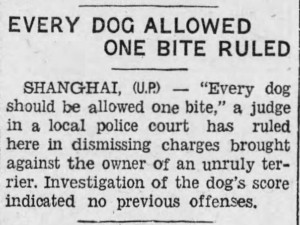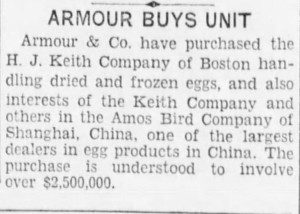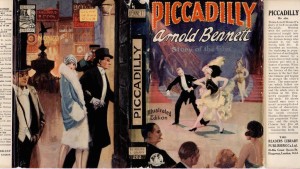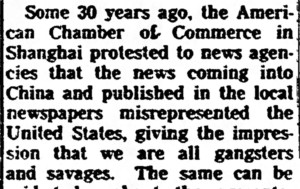Posted: June 30th, 2015 | No Comments »
Dogs are definitely back in Shanghai after decades of being discouraged, banned and simply unaffordable…the last decade has seen a massive rise in dog ownership and, I guess, dog bite incidents. Any judge in the city now faced with a case regarding dog bites can, should they choose, revert to 1936 precedent and Shanghai treaty port law and invoke the ‘one bite’ precedent….

Posted: June 29th, 2015 | No Comments »
A quick plug for an event I’m moderating in London….ticket details and booking here….

Hyeonseo Lee was just seventeen when she fled North Korea. She found herself in China, alone and with no identity. Her mother’s first words over the telephone to her lost daughter were “Don’t come backâ€.
In her memoir The Girl with Seven Names, Lee recounts her life inside the secretive and brutal communist regime: the ‘self-criticism’ classes in primary school; forcibly joining the Youth Corps aged nine; and witnessing public executions of people who had not mourned enough for the death of Kim Il-Sung. She describes her escape and brave efforts to persuade her mother and brother to join her.
We are pleased to welcome Hyeonseo Lee to the Frontline Club to share her insight into growing up North Korea, the story of her escape and how she went on to rebuild her life and discover her identity. She will be talking to Paul French, an author and a widely published analyst and commentator on Asia, Asian politics and current affairs. He is author of North Korea: State of Paranoia and the international bestseller Midnight in Peking.
Hyeonseo Lee lived in North Korea until her escape in 1997. She arrived in Seoul in 2008, where she currently lives, and has recently graduated from Hankuk University of Foreign Studies. As a student, she was a Young Leader at the Center for Strategic and International Studies, a journalist at the Ministry for Unification and a selected member of the ‘English for the Future’ programme at the British Embassy in Seoul. She is an international campaigner for North Korean human rights and refugee issues and speaks on the subject all over the world, including at the UN and the Oslo Freedom Forum.
PLEASE NOTE THIS EVENT WILL BE FILMED AND STREAMED LIVE ON OUR YOUTUBE CHANNEL

Posted: June 29th, 2015 | No Comments »
Franco David Magri’s Clash of Empire in South China examines the military operations that emerged from the Japanese invasion of Southern China…

Japan’s invasion of China in 1937 saw most major campaigns north of the Yangtze River, where Chinese industry was concentrated. The southern theater proved a more difficult challenge for Japan because of its enormous size, diverse terrain, and poor infrastructure, but Generalissimo Chiang Kai-shek made a formidable stand that produced a veritable quagmire for a superior opponent–a stalemate much desired by the Allied nations. In the first book to cover this southern theater in detail, David Macri closely examines strategic decisions, campaigns, and operations and shows how they affected Allied grand strategy. Drawing on documents of U.S. and British officials, he reveals for the first time how the Sino-Japanese War served as a “proxy war” for the Allies: by keeping Japan’s military resources focused on southern China, they hoped to keep the enemy bogged down in a war of attrition that would prevent them from breaching British and Soviet territory. While the most immediate concern was preserving Siberia and its vast resources from invasion, Macri identifies Hong Kong as the keystone in that proxy war-vital in sustaining Chinese resistance against Japan as it provided the logistical interface between the outside world and battles in Hunan and Kwangtung provinces; a situation that emerged because of its vital rail connection to the city of Changsha. He describes the development of Anglo-Japanese low-intensity conflict at Hong Kong; he then explains the geopolitical significance of Hong Kong and southern China for the period following the German invasion of the Soviet Union. Opening a new window on this rarely studied theater, Macri underscores China’s symbolic importance for the Allies, depicting them as unequal partners who fought the Japanese for entirely different reasons-China for restoration of its national sovereignty, the Allies to keep the Japanese preoccupied. And by aiding China’s wartime efforts, the Allies further hoped to undermine Japanese propaganda designed to expel Western powers from its Greater East Asia Co-Prosperity Sphere. As Macri shows, Hong Kong was not just a sleepy British Colonial outpost on the fringes of the empire but an essential logistical component of the war, and to fully understand broader events Hong Kong must be viewed together with southern China as a single military zone. His account of that forgotten fight is a pioneering work that provides new insight into the origins of the Pacific War.
Posted: June 28th, 2015 | No Comments »
Despite repeated state media claims that Shanghai is intent on protecting its heritage it is reported that the former Amos Bird building on the Bund has been demolished. The structure on the North Bund was built in 1921 and was the egg packing and storage warehouse for the company. It was classified as an “immovable cultural relic” in 2011 but this does not appear to have made any difference once the developers decided they wanted it gone. Before 1949 the building was the largest refrigeration and storage site in the city. Amos Bird had operated on the site in one form or another since the First World War.
In the Chinese media the Amos Bird has been described as a “British Company” but I believe it was, in fact, an American company and was the Shanghai off-shoot of the HJ Keith dried egg company from Minneapolis, Minnesota but was registered and HQed in Boston. They sent a certain Morris Ovson, a Russian, to Shanghai in 1917 to establish a business producing dried and frozen eggs for export. He started the Amos Bird business in China. It was later incorporated into the Armour & Co. meat processing company of Chicago in 1929, as the newspaper article from August 1928 below shows.
Apologies but I don’t have a photo of the building in my records…if anyone does obviously I’d like to see some old shots of the building?

Posted: June 27th, 2015 | No Comments »
You’ve probably seen the movie with Anna May Wong, but have you read the book…the lovely cover of Arnold Bennett’s Piccadilly….

Posted: June 26th, 2015 | No Comments »
As I’ve noted in previous posts the American Chamber of Commerce in Shanghai is celebrating its 100th anniversary and has been posting rather a lot of interesting articles on the glorious history of Americans in Shanghai. But they’ve been rather judiciously edited to prevent any talk of disagreements among the Americans in Shanghai. It seems worthwhile telling a few extra tales that somehow slipped off the official record!
In my posts on the real relationship between the AmCham and two notable American journalists in China, J.B. Powell, Carl Crow and Hallett Abend, we’ve seen how the organisation attempting to suppress opinions by Americans in Shanghai that they did not approve of. Indeed the letters pages of the major American-owned and run newspapers in Shanghai between the world wars, notably the China Press, are full of letters from irate AmCham officials complaining about their fellow Americans who refused to follow the “business first” line that has always been the leit motif of the AmCham in Shanghai (BTW: in this they are not exceptional – all Chambers of Commerce everywhere tend to be like this and Shanghai was no exception – the French Chamber of Commerce shamefully rallied to Vichy in 1940 claiming that resistance would damage business, whilst it is harder to imagine a more reactionary organisation than the British Chamber of Commerce in Shanghai throughout its incarnation which spent most of its time lamenting the end of the Qing Dynasty- i.e. a monarchy – and the birth of that awful thing, a republic!).
But AmCham didn’t just confine itself to trying to suppress American journalists and correspondents in Shanghai. Indeed, it went further and complained vocally and vociferously back in America about how the American media itself portrayed America! George Sokolsky (a most interesting character who veered in his lifetime from the extreme left to the extreme right) noted in 1955 how 30 years before the Shanghai AmCham had taken it upon its self-aggrandised self to tell the American media how it should report on its own country. A bizarre thing to do to say the least and calling for the American media to basically become a propaganda vehicle for the country so American business could sell a few more Parker pens, Buicks and insurance policies. I’m happy to report the American media paid no attention whatsoever to the Shanghai AmCham and carried right on reporting on America the way it saw fit….

Posted: June 25th, 2015 | No Comments »
The American Chamber of Commerce is celebrating its 100th anniversary and has been posting rather a lot of interesting articles on the glorious history of Americans in Shanghai. But they’ve been rather judiciously edited to prevent any talk of disagreements among the Americans in Shanghai. It seems worthwhile telling a few extra tales that somehow slipped off the official record! Journalists were a particular bête noire of the AmCham Big Cheeses (see their attempt to expel JB Powell yesterday).
And so talking of journalists running into trouble with the AmCham, today one of my Shanghai heroes Carl Crow, intrepid American Journalist and pioneering adman in the city – the article is here.
The AmCham are, of course, quite right to describe Crow as “One of our early celebrity members…” – he was indeed, as well as being a pioneering adman in China, hostage negotiator also….a lifelong friend of AmCham Shanghai Black Hats Target No.1 J.B. Powell. After the AmCham, then in the thrall of the corrupt businessman Frank Jay Raven, attempted, in contravention of their own constitution, to expel Powell, Crow, like Powell, had little-to-nothing more to do with the organisation and openly criticised it for being reactionary, anti-Chiang Kai-shek and against the Republic – all of which AmCham decidedly was. Crow, like Powell too, also felt that the Shanghai AmCham was too soft on Japan and failed to recognise the serious threat Tokyo offered to China’s liberty. Of course Powell and Crow were right and the AmCham wrong on that one – very, very right and very, very wrong respectively.
And so at the start of 1937 Crow was working on a book to be called The Chinese Are Like That, another attempt by him to win over American public opinion to the cause of China, the dangers of Japanese militarism and to try and engender additional respect for China in the US among mainstream readers. Though the book was not published until 1943 it does reflect how enthusiastic Crow was regarding China and Shanghai back in 1937 and how he understood clearly the threat Japan posed to China. But, when it came to the Shanghai AmCham, talking about Japan’s overt militarism and clear expansionist aims was still, as late as the summer of 1937, both unfashionable and considered unhelpful to American business interests and they set about trying to silence anyone who raised the issue.
In January Crow was rebuked in a letter from one of the founders of the American Chamber and the then US Commercial AttacheÌ in Shanghai, Julean Arnold, requesting that he soften his public criticisms of Japan. Arnold claimed that Crow was being un-American (a term that would later come to instil fear in many China Watchers hearts when the arguments over ‘Who Lost China?’ appeared along with a certain Senator from Wisconsin) and that his patriotic duty was to soft peddle on Japan in the interests of, of course, American business. Crow refused but did keep the letter (dated 15 January 1937 from Arnold of the AmCham to Crow contained in the Carl Crow Archive, folder 133 – this archive can be accessed either at the University of Missouri’s Western Historical Manuscripts collection or, in replica form, in the Royal Asiatic Society’s Shanghai library). Another journalist (and a great American reporter), Hallett Abend of the New York Times, reported large and threatening Japanese troop build-ups in Korea and Manchuria around the same time and was chastised for his reporting by the American Chamber in Shanghai as being “alarmist”.
In July 1937 Japan launched attacks against Peking and Tientsin and captured those cities. On “Bloody Saturday” August 14th 1937 Japan began its attack against Shanghai and on December 13th began the six week terror of the Rape of Nanking….just months after AmCham asked Crow and Abend to keep quiet!

Crow – un-American?? We think no; AmCham shamefully thought yes

Hallett Abend – “alarmist” said AmCham; but more a prescient warning from a great reporter
Posted: June 24th, 2015 | No Comments »
As I noted yesterday (see my post on the history of Sterling Fessenden AmCham didn’t want you to know) the American Chamber of Commerce in Shanghai is celebrating its 100th anniversary and has been posting rather a lot of interesting articles on the glorious history of Americans in Shanghai. But they’ve been rather judiciously edited to prevent any talk of disagreements among the Americans in Shanghai. It seems worthwhile telling a few extra tales that somehow slipped off the official record!
Today, the great J.B. Powell, fearless American journalist in Shanghai and a teller of truth to power (including the AmCham) for which he usually got in trouble (particularly with the AmCham!!) – the article is here.
Now while Powell is a great hero in many ways, plenty of them noted in this article, it somehow forgot to mention that the powers-that-be at the AmCham in Shanghai, allied with various corrupt American business interests in the city at the time, ignominiously booted him out of the organisation when he said what they didn’t like to hear…They can claim him as a great American in Shanghai but they should really acknowledge that, at the time when AmCham Shanghai was under the sway of some pretty corrupt individuals, they tried to expel him….

In 1927 J.B. Powell published a famous “New China” special edition of his China Weekly Review. In it he argued that Chiang Kai-shek, then engaged on the Northern Expedition and having just taken Hankow and Nanking from warlords for the Republic, was here to stay. This opinion – however valid and self-evident to most – didn’t suit many in the AmCham (who would presumably have thought of themselves as diehard republicans in their own country). Prompted by a senior member of the AmCham, the corrupt businessman Frank Jay Raven (more of him later), they hastily convened a meeting which, contrary to the organisations own stated by-laws and in the sway of crooked American business interests, attempted to expel Powell. Powell was a strong supporter of Chiang, the republic and a unified China while many in the upper ranks of the AmCham ridiculously considered Chiang a “Bolshevik”.
Fortunately not everyone agreed with the super-dodgy big cheeses at the AmCham – Powell’s “New China” special was the best selling issue of the Review ever and had 100 advertisers, mostly American companies who continued to place advertising with Powell despite being discouraged from doing so by the AmCham, who declared his opinions as now ‘beyond the pale’. It is to the adverisers credit that they resisted the pressure from Frank Jay Raven-controlled AmCham and saw that the future lay with Chiang and the KMT. As Edgar Snow commented (then a young man working for Powell after having recently arrived in China and soon himself to be castigated by the AmCham for his left wing opinions), he “plagues the American money-grabbers in Shanghai”.
It should also be noted that most sensible China watchers rallied to Powell’s defense against the AmCham – for instance Asia: The Journal of the American Asiatic Association called AmCham’s tactics against Powell “highly intimidatory” and argued that his only crime was being “too liberal” for the AmCham’s decidedly reactionary tastes. It was also noted by many that extreme American reactionaries, such as the notorious George Bronson Rea, who had long advocated Japanese occupation of China, were never considered for expulsion from the AmCham – even after the summer of 1937 support for Japan was not enough to get you kicked out of the AmCham in Shanghai.
It is also worth remembering that the AmCham’s support for the suppression of the 1927 strikers in Shanghai (which led to their massacre thanks in large part to the actions of Stelring Fessenden – see yesterday’s post – was opposed by the President (that’s the President of the United States of America!!) and the Secretary of State in D.C. – not only did the AmCham take sanction against someone they disagreed with but they openly defied American policy from the Oval Office down!!
For the record…Powell’s own recollection of the events from his autobiography My 25 Years in China….shortly after Powell’s “New China” edition…
"the board of directors (of AmCham) called a special meeting of the chamber and formally
requested the resignation of the editor of the China Weekly Review because of the paper's
editorial policy. Although an active member of the chamber almost from the date of its organization
in 1917, I was not notified of the special meeting and only through accident learned of it in time
to reach the meeting place before the vote on the resolution was taken. I had that morning received
another telegram from the Review's Washington correspondent, Mr. Underwood, confirming further
the opposition of President Coolidge and Secretary of State Kellogg to any armed interventionist
program, and had a copy of it in my pocket when I went to the meeting. The meeting was attended
by only a small percentage of the membership, and as I looked over the gathering I had a feeling
that it was a "packed" meeting. My surmise was borne out when the members present, one after
another, got up and condemned the China Weekly Review for its editorial attitude as being
contrary to the interests of American business in Shanghai and of foreigners generally in China.
Before a vote was taken I stated that I realized fully the seriousness of the crisis in China,
but was convinced that armed action by the Powers would only have the effect of strengthening
the radical elements and their Soviet supporters who were trying to overthrow the moderate KMT
faction, led by General Chiang Kai-shek. I also explained that the views I had expressed editorially
in the Review coincided with the traditional views of the United States Government, and
particularly with the views of the Administration leaders. I then read the telegram I had received
that morning from Washington, which further confirmed the previous message, that Washington was
opposed to armed intervention, except for the protection of the lives and property of American
citizens from mob violence.
I had scarcely resumed my seat when a local American lawyer, Chauncy P. Holcomb, a Delawarean,
and a former District Attorney attached to the United States Court for China, got up and made
a fiery speech in which he denounced the "pusillanimous" policy of the United States Government
and charged that the China Weekly Review "was largely responsible for the attitude of our home
authorities In letting the Americans and other foreigners down." Before the vote was taken someone
raised a parliamentary question by calling attention to the by-laws of the chamber, which provided
that no member of the chamber could be expelled without due notice in writing being given and a
certain number of days permitted to elapse so that a formal reply could be made. But the members
present would not listen to opposition, even on constitutional grounds, and passed the resolution
by a considerable majority. I immediately declared my determination to continue my editorial policy
and refused to comply with the chamber's resolution demanding my resignation unless the chamber's
action was confirmed at a meeting called for the purpose in accordance with the by-laws
of the organization.
No such meeting ever was held."
Powell goes on to claim that various American business interests that dominated the AmCham,
namely the "Raven Group" led by Frank Jay Raven, a crooked American businessman (who to be fair the
AmCham now - while praising in general - admit was dodgy - here) were out to get him and anyone
who put principle before business. You can read all Powell's autobiography here.
 Frank Jay Raven - a crook who successfully sought to influence the Shanghai AmCham to extreme
reactionary positions and led the charge to expel Powell
Perhaps that little altercation between Powell and the AmCham might have been worth including?? Don't ya think??
(BTW: for anyone who wishes to read the "New China" edition of the China Weekly Review from 1927
I did donate a bound copy of it some years ago to the Royal Asiatic Society's library in
Shanghai, where I assume it still resides)
Frank Jay Raven - a crook who successfully sought to influence the Shanghai AmCham to extreme
reactionary positions and led the charge to expel Powell
Perhaps that little altercation between Powell and the AmCham might have been worth including?? Don't ya think??
(BTW: for anyone who wishes to read the "New China" edition of the China Weekly Review from 1927
I did donate a bound copy of it some years ago to the Royal Asiatic Society's library in
Shanghai, where I assume it still resides)










 Frank Jay Raven - a crook who successfully sought to influence the Shanghai AmCham
Frank Jay Raven - a crook who successfully sought to influence the Shanghai AmCham